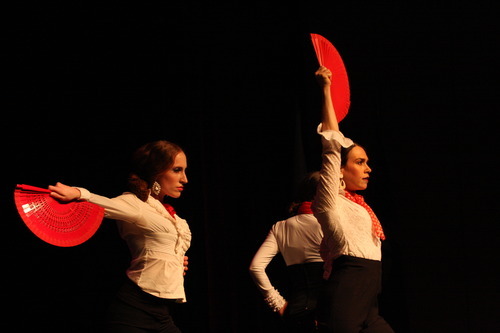How to Create a Performing Arts Video Work Sample (Part 1 of 3): Your Video Is an Artifact
Questions to ask: How’s it watched? What’s it for?
A video work sample is a tool you should probably have if you create work in the performing arts. Many grant applications and festival submissions require it, and even if they don’t, your application still may need one in order to be competitive. Take a look at the choreographers, theater and performance artists who are getting funded and programmed, and you’ll see that they have video: probably lots of it, probably well filmed.
While the funders and presenters I spoke to for this article placed varying degrees of importance on the video work sample, all of them vouched that strong documentation of your live performance can give your application a considerable edge. With the increased availability of rudimentary filming equipment like smart phones and flip cams, as well as free editing software, most funders have come to expect that performers applying for funding will have at least some kind of footage to show them: in fact, many expect that artists will invest in technology and services to produce a more professional sample. So, bearing that in mind …
What makes a good work sample?
A good work sample video draws you into the performance. It makes you feel like you’re there. And it compels you to keep watching. The goal is to help the viewer connect with the performers and to understand viscerally the feeling of the work and its context.
This requires balance: Neither a static full-stage shot from the back of the house nor a frenetically manipulated music video of a work sample is ideal. Both options remove the viewer from what the performance actually intends to evoke. The sweet spot is something in-between that feels like watching the piece live from the front row. Achieving this is an art form of its own, and requires striking a balance between viewing the work as a live performance and viewing the work as a film.
As Richard Move of MoveOpolis! and Move- It! Productions says, “you are creating a different object” with your video work sample. Performing artists are particularly adept at working with what’s at hand and calibrating work for a particular venue. It may be helpful to consider your short video excerpt as a new piece of art, staged in a new (virtual) venue for a new audience (of panelists).
A strong sample presents you as a competent artist who knows what you’re doing. Your work sample is PROOF that you can do the kind of work you’re proposing to do — and, vitally, it’s not boring.
How will your work be watched?
“If panelists can’t see your work, they can’t give you any money” – Moira Brennan, MAP Fund
This is huge. HUGE! It’s the reason I chose to write this article, because until attending a NYFA Fellowship panel and actually witnessing panelists watching video work samples, I had no idea how important it was for performers to ask themselves the question, How will my work be watched? It hadn’t occurred to me that, just as I consider the venue and the audience and the context of my work for live performance, so should I consider the setting in which my video work sample would be viewed.
In most cases, the people evaluating your video are watching it in the midst of a serious work sample binge. They’re probably fast-forwarding through parts. They may not watch past the first half-minute. They are judging your work very, very quickly.
In this fast-paced, marathon viewing context, errors like hard-to-see or hard-to-hear footage; slow starts; awkward, Star Wars-style scrolling text; and malfunctioning video links or DVDs are magnified. It would be harsh to say that panelists are looking for an excuse to cut you, but during a long day of watching short videos in a dark room, they may be more easily bored or frustrated by your video if there are problems. With potentially hundreds of clips to get through, they aren’t afforded the luxury of patience with your work.
Many funders go into detail in their guidelines about how your work will be viewed. Many also encourage questions from applicants. The specific conditions in which they watch your video will affect their experience of it. Low-resolution video may look fine if they are streaming it on small laptops, but grainy when projected onto one big screen. Some funders prefer to be given video of the entire work with suggested cueing points to watch, while others just want short, individual clips. Sometimes links to streaming video online are preferred to physical DVDs — and sometimes vice-versa. Learn as much as you can about funders’ and presenters’ preferences in order to present your work as strongly as possible.
Your video work sample is part of an application
“Help us imagine the 3D version of your performance from your 2D application” – Andrew Kircher, Under the Radar
This is the other side of the coin. Your video work sample should be intriguing and expressive of your unique artistic perspective all on its own, but it won’t be evaluated in a complete vacuum. Some panels will have read your proposal before seeing your work sample, and some won’t: NYFA Artists’ Fellowship panels, for example, view a first round of work samples before seeing any application statements. Other funders stressed how important the work sample description was in preparing their panelists to view the sample in context. Again, finding out the manner in which your application materials will be considered empowers you to present them in the best possible way.
Your application materials are like artifacts: unless the people evaluating them are already familiar with your work, they will have to piece together a sense of who you are as an artist from the limited information that you submit. A solid application will help them reconstruct the fragments by mapping out connections among your documented accomplishment in the video work sample, your vision for the work in your written narrative, and their own funding or presenting goals.
Most applications will give you the opportunity to describe the work sample, and you should absolutely take advantage. (Many people don’t.) Here is your chance to articulate what is important about your work and to point out these ideas in action. Moira Brennan from the MAP Fund suggests that artists “get nuts and bolts about it” — focus specifically on how their technique and ideas function within the work sample. Do so, and you will avoid falling into the trap of telling the panel how they should feel about your work, or of making assumptions about the audience’s experience.
Well-written work sample descriptions from NYFA Fellows have:
- Stated basic information about the work: the artist’s role in creating it, the type and length of work (short- or full-length, workshop or full production, etc.), the name of the venue, and collaborators
- Described design and performance choices (gestures, staging, lighting, etc.) in relation to the central themes and goals in the artist’s work
- Located the work within a tradition of practice and explained the ways in which their sample both aligned and branched from that tradition
- Framed the footage within the atmosphere of the performance – describing the venue, the audience layout, and any other circumstantial factors like audience participation or duration that may not be obvious to a first-time viewer of the footage.
- Included brief narrative context if necessary
- Explained notable filming conditions — being clear and upfront about unusual choices, like footage that was reshot post-performance, the use of rehearsal video, or subtitles for patchy sound
For applications to presenters, you may be able to send a rider along with your sample and other materials. Andrew Kircher from The Public’s Under the Radar Festival suggested that the technical details and drawings in your rider can help presenters more fully imagine your work in performance.
Matching your sample to the application
“Show us you can do this work” – Katie Tuss, Queens Council on the Arts (QCA)
We’ll get into the nitty gritty of selecting video excerpts later in this series, but it’s worth mentioning early on: Each application is a unique snowflake. For some programs, your work sample may make or break your application, and the ability to compellingly demonstrate the artistic merit of your work is essential. For others, the work sample will be treated as a supplement used to reinforce the rest of your proposal, and in some cases may not even be screened for the people making funding decisions.
If you are applying to fund or present a specific project, your work sample should imply your potential to pull it off. For instance, if you’re a dancer proposing a site-specific solo piece, you might choose to share past work that exhibits your use of a non-traditional space with a single dancer. If you’ve only done large group dances on proscenium stages, you might choose to split your work sample between that older footage and video of a rehearsal for the solo piece, using the written application to address how you will adjust your process for this new territory.
The general rule of thumb for work samples of all kinds is: depth over breadth. It may feel counterintuitive or even abhorrent to collapse your artistic identity into a box for an application. But again, keep your panelists and presenters in mind; help them get a sense of you within this limited format by narrowing your focus and sharing a few specific ideas with them. They know that they’re just getting a glimpse of your work – it’s your opportunity to make them want to see more. Your application and your work sample together should highlight your main methods, interests, themes, influences, and tastes. What are the hallmarks of your work? If audience participation plays a key role, include footage of it in your work sample. If projection is an important aspect of your work, capture video that illustrates your use of it in live performance.
Many local arts councils and social practice funders focus on projects that engage the community. For these applications, illustrating your work’s alignment with the funder’s social goals may be a priority. For instance, a community-based children’s theater pursuing student engagement and diversity should demonstrate these qualities in their work sample.
Finally, always be filming. If you are diligent about documentation, making sure to record readings, workshops, and appropriate rehearsals as well as all finished work, you’ll soon build up an assortment of footage from which to choose. This video can be useful to your artistic process, as well as supply you with more material for fundraising and marketing efforts. For applications, the ideal is to have options, so you can easily support claims made in each individual narrative with specific evidence in your video work sample.
Takeaways from Part 1:
- Performance documentation is an art form of its own
- Learn how your work will be watched
- If an application allows you to describe your work sample, take advantage of the opportunity
- Always be filming – more footage means more options
Next: Part 2 — Plan, Then Shoot: Tips for Hiring a Pro or Doing it Yourself.
— Lisa Szolovits is NYFA’s Researcher, Artist Resources.





